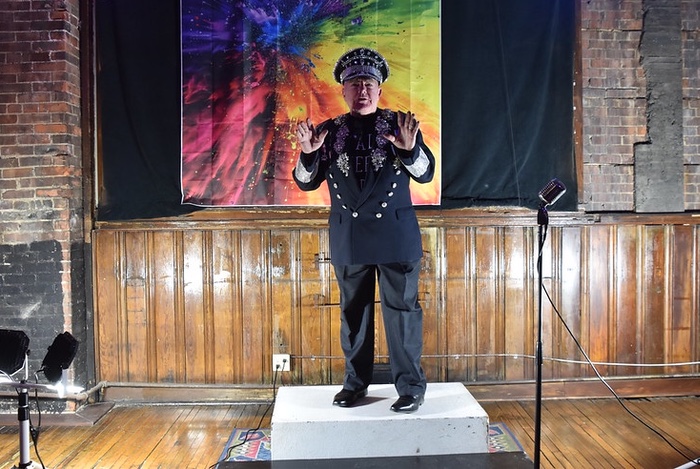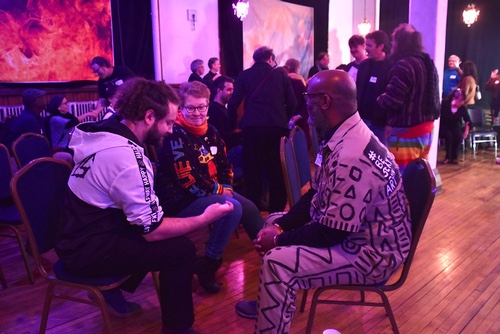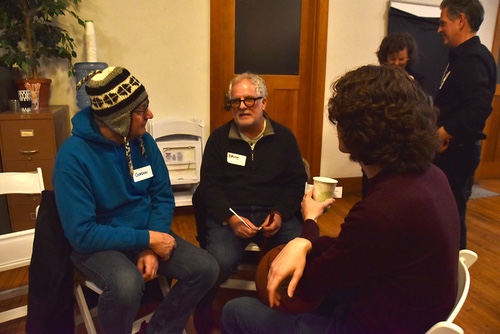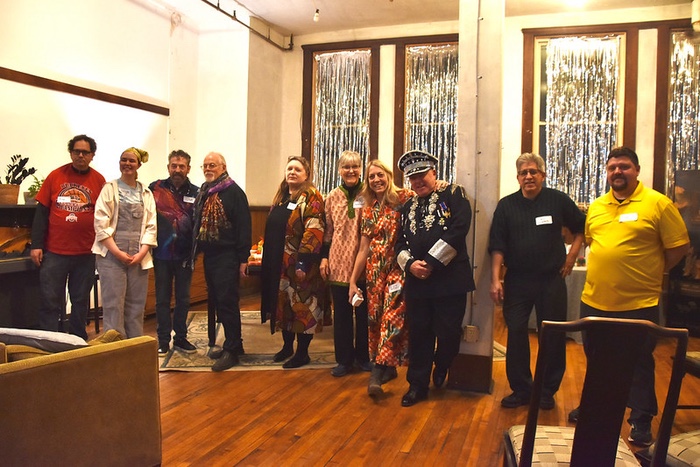
On a snowy Saturday night in January, over a hundred artists, musicians, writers, art lovers, retired arts administrators, and several dozen people from the public poured into the Brownhoist Building in midtown Cleveland. I did not know what to expect. No one did.
The four-story building dates back to 1880 as the offices of the Brown Hoisting & Conveying Machinery Company. It expanded in 1901, owned by the Columbia Electric Manufacturing Company from 1941 to 1991 and by lawyers from 1991 to 2023. Adam Whiting, a musician by training, bought the 145-year-old office building in March 2023.
Local creatives want a new festival after the cancellations of FRONT and CAN Triennials; both festivals fell short of expectations. COVID hit. Funding got canceled. Artists were scratching their heads, wondering what to do next. FRONT International invited the international cultural elite to witness the glowing fill-the-vacancy of contemporary art in Cleveland, a proposal not entirely bought by local artists except for a handful that received recognition and exhibition opportunities. CAN Triennial never quite found its footing.
They are both gone, with no plans to return any time. Liz Maugans, co-organizer of Quest for the Fest, got to work.
With artists David King, Darl Schaaff, Stormy Sweitzer, Steven Calhoun, Linda Zolten Wood, and a dozen other talents, Maugans took the lead in ultimately creating a fest for the people, by the people, and with the people. In the current electric political climate, it is a big ask and an even bigger hole to fill. She greeted people as they entered the building, holding the door open for them.
Once inside, participants signed a waiver releasing organizers from potential harm and agreeing to a “trust us” path of experiences. We got a two-inch square chip with Wonder Quest #1, Roots of Creativity, printed on one side and a graphic illustration of air, water, earth or fire on the other. We proceeded to the second floor and joined our group. I had the symbol for air, which was easy enough to find. The other three groups sat in the performance space. The atmosphere was festive and mysterious. Mingle, the organizers suggested. Find someone you do not know and introduce yourself.
I looked around the room to find many familiar faces. Others I had seen in public but did not know personally; there were a lot of unfamiliar faces. Without paying much attention, I sat in a folding chair next to Happy Dog owner Sean Watterson. He was in conversation with two other people about the state of the music industry in Cleveland. Watterson is a tireless advocate for the National Independent Venue Association (NIVA). I introduced myself to the larger group.

Darl Schaaff, dressed in a sparkling costume, theatrically took center stage and explained what was next. Maugans added, “Imagine there is no art.”
We checked our chip for a number and looked for others with the same number in our group. I paired with two other people and we spent a few minutes reintroducing ourselves, explaining who we were and why we were there. Afterward, confident that I had found my tribe, I fell in line to the third floor, where we met in groups. We sat in a semi-circle. Our group leader handed us strips of paper with the identity of an unknown person and asked us to become that person and work with our two partners to develop a creative project, which we would present to the group. Several tables had props on them. We selected one or several items for our character. In for a dime, in for a dollar, I thought. I went along with the game.
My character was Ravi Sharma, 43, in Minneapolis, MN. Ravi was a software developer and sitar player. His father, a classical musician in India, inspired him to blend traditional and digital art forms. Ravi dreamt of creating an interactive installation that combined sound, light and storytelling. There was no sitar in sight. I grabbed an old Kaval flute. Close enough.
Tim and Gordon were my partners. Each had their character descriptions. We settled on sports and art-related events. Our theme suggested combining them. More elaborate halftime shows with local artists contributing to the over-the-top performances? Not a bad idea, we figured. We shared ideas as we went around the room, some participants inhabiting their characters in real performance time.

“I think we have a few theater people in our group,” said Tim.
We explained our project. Honestly, it was probably the least interesting in the group. No one talks about sports and the arts in the same sentence, especially locally. The curse of another tragic Browns season and the likelihood of the team leaving for Brook Park is too much. We have a world-class art museum in our backyard and a fantastic orchestra, the envy of the musical concert world. Let the Browns leave. Keep the Cavs and Guardians. Enough said.
We were an enlightened group and festive. An assortment of possibilities and projects, public events, and celebrations, most culturally based, were brilliantly possible. What if there were no art, as suggested by Maugans in the introduction? We would have to make our homegrown brew. Applause broke out at the end of our group session. Participants shed their inhibitions, collaborated with people they never met before, and had fun.
Later, the four groups selected one person or several from each group to present with their Wonder Quest and origin stories. One group worked collectively to reimagine the arts using materials. Another group analyzed their emotions about the fantasy that art no longer existed. A fourth group made a shield, badge or family crest for creatives, a lineage project.
Almost two hours later, Schaaff took to the stage and congratulated everyone. The swirling disco ball projected colorful light in all directions. He appeared magical. Music blared in the background from Gina Washington, DJ for the night. The bar with food was free.
“These quests tapped into the literary, visual and performance arts to bring people together through creativity,” said Maugans over coffee a few days later. “We found out that art is very much alive.”
At a group Zoom meeting weeks later, organizers congratulated themselves for a successful event, as they should have. The event was mesmerizing and beautiful; plans for another project were enthusiastic. Many recognized that Wonder Quest Roots of Creativity was exhausting. None of this would have been possible without the volunteerism of artists and creatives determined to bypass the large, bulky, and ineffective institutional efforts to organize the creative community. Donations drove the free event.
Quest for the Fest next meeting is April 6 @ 1 pm, location TBD. You will not want to miss this. Trajectory, because of the Roots of Creativity project, has created several interesting yet-to-be-revealed future possibilities for artists and creatives. More information is on Facebook at Quest for the Fest. All are welcome to particpate!
